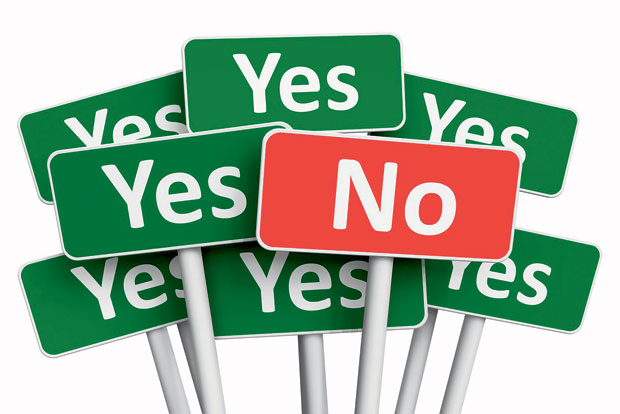The Power of “No”
Do you have trouble putting your own needs first? Drawing from your inner strength and sense of self can reveal a solution that’s fair to you and others
QUESTION OF THE WEEK: I want to start saying “no” to others because I am beginning to tire of doing things for everyone else all the time and putting myself last. You always talk about using the home to support our new endeavors. Is there anything I can do to support this change in what I want to say? I feel like a doormat of sorts, yet I just can’t say “no” because I feel guilty if I do. I don’t know where to start. Can you help?

Yes, I can help. What a great question, and I’m sure you are not the only one who feels this way. Many of us face this challenge, and when you reach the point where you are feeling drained, it’s time to seriously address it. The greatest gifts you can give yourself are to recognize who you are and the value of your time. In my daily work with clients, I have noticed a trend toward becoming more focused on our own needs and looking for ways to make changes without feeling selfish or offending others along the way.
Engage your environment for support
Once you are intent on a new course of action, start the process of change by engaging your environment for support. Subconsciously, we respond to the messages of our environment on an energetic level. The key here is to ensure that your environment supports the change you want.
Drawing stronger boundaries
In order to support yourself in drawing stronger boundaries with others, look around your home or office and implement the following:
• Group any scattered or miscellaneous items in plain view. Put them in a decorative basket or pretty container, creating constant visual support that you are “containing” your energy, not dispersing it all over the place. • Stack random magazines or papers in an orderly fashion, showing symbolic alignment, or balance, between what you are doing and what you are feeling. • Group like items, such as a collection of dog figurines, or decorative items that have the same color, for power, symbolically focusing your energy and ability to act from a strong sense of self.
• Place images of strength—artwork of a bamboo forest, a strong tree or a shining sun—on your walls to remind you of your own inner fortitude and power.
• Get a new doormat, one that is “healthy” and not worn down. People step on door-mats before they enter the home, and a new doormat sets the intent to change the past.
Dealing with feelings of guilt
As for feelings of guilt, saying no is difficult because we feel responsible for others’ challenges, especially if they have come to depend on us, but if we look deeper, we may discover the positive side of saying no, not just for you, but for the person on the receiving end.
To get over some of the guilt, take the time to consider what you truly want. When you introspect to discover the benefits of saying no, you might discover that they far outweigh the negatives.
Balancing Perceptions
Consider the bigger picture. Balance your perception of the situation by making a list of the benefits of saying no. For example, ask yourself if it could possibly be an opportunity for someone who actually wants to help to step in for a change? Will it foster more openness in your relationship and diminish any resentment that could erode it? When you fail to even consider the benefits of saying no, you are probably focusing on the negatives: the disservice to the other person or the fact that you are being selfish. But the benefits can be far more inspiring: freeing yourself up to do the things you really want to do and presenting the opportunity for the other person to broaden his or her horizons by thinking of alternatives.
Practice saying no
Your time is yours to spend the way you want, and no one has a claim on it, unless you allow it. William Ury wrote a wonderful book entitled, “The Power of a Positive No.” In it, he reminds us that the first “yes” should be to ourselves. It shows respect for your own time and space, allows you to embrace your own personal interests, and sets the stage for a positive no. The second “yes” is designed to keep the relationship mutually beneficial. That means showing the other person respect by treating him or her as you would want to be treated when someone says no. Finally, saying no should be a positive experience for you and the other person. A positive no means you encourage the other person’s strengths and ability to handle the situation, speaking from the heart, rather than reacting, building your own confidence in the process.
Saying no
Creating the right energetic support and learning to say “no” clearly but fairly will help you heal the “disease to please” in a healthy and positive way. The more you know who you are and what you want, the easier it becomes to say no. It really is okay to choose yourself when you need to! Just remember to do it so that everyone feels better in the end.
Alice Inoue is a life guide at Alice Inoue Life Guidance LLC, a company committed to assisting people in living empowered lives. Alice shares her wisdom as a professional speaker and personal consultant, and offers a series of instructional DVDs on feng shui, as well as her award-winning books on feng shui, happiness and spiritual life wisdom. Visit www.aliceinspired.com to read her blog, sign up for her newsletters and download useful feng shui tips.